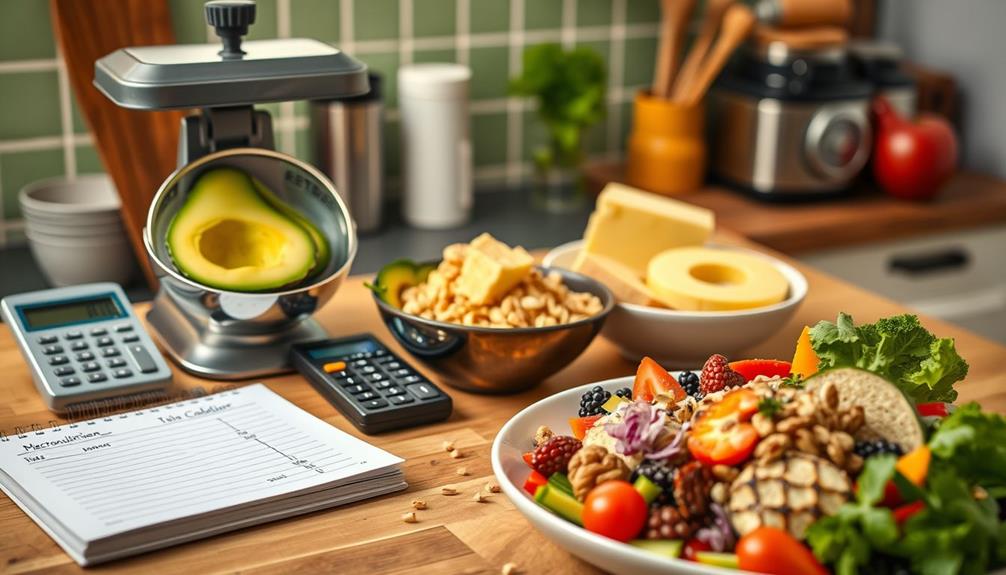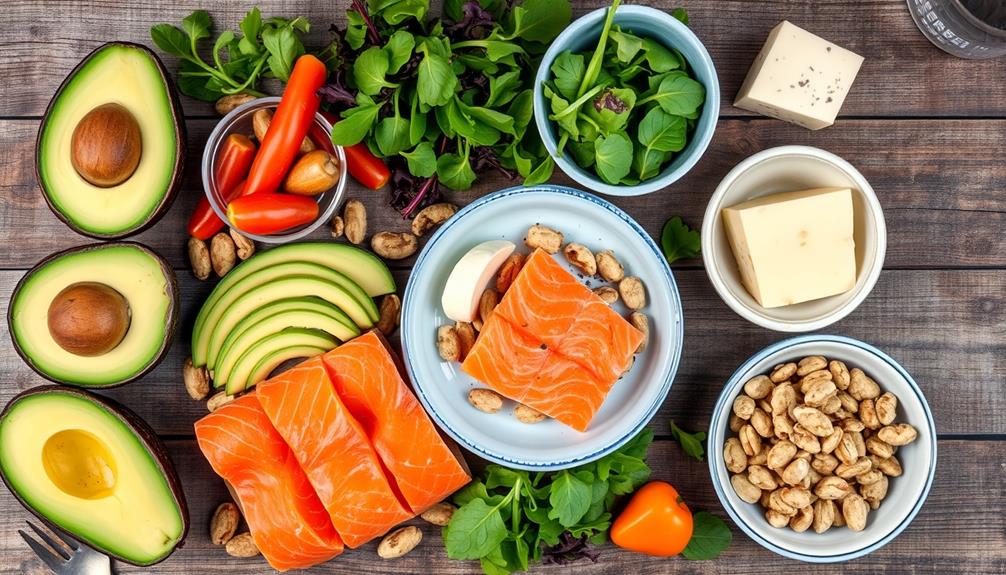To master macronutrient ratios for keto, aim for 70-75% fats, 20-25% proteins, and 5-10% carbohydrates. Staying within these ranges can help you enter and maintain ketosis, boosting energy, promoting weight loss, and curbing hunger. It's essential to track your intake using apps like MyFitnessPal or Carb Manager to avoid mismeasuring portions. Be mindful of potential risks, such as nutritional deficiencies or the "keto flu." By making smart nutritional choices and using effective tools, you'll enhance your chances of success. There's plenty more to explore about optimizing your keto journey and achieving your specific goals. Understanding nutritional labels is crucial for accurately tracking your macronutrient intake. By carefully reading labels and calculating serving sizes, you can ensure that you stay within your desired ratios. Additionally, educating yourself on the different names for sugars and other carbohydrates can help you make informed food choices and avoid hidden sources of carbs. Taking the time to understand nutritional labels will empower you to make the best decisions for your keto journey.
Key Takeaways
- Aim for 70-75% fats, 20-25% proteins, and 5-10% carbohydrates to achieve ketosis effectively.
- Choose the right type of keto diet based on personal goals, such as Standard, High-Protein, or Cyclical Keto.
- Utilize tracking apps like MyFitnessPal to monitor daily caloric intake and macronutrient ratios accurately.
- Be aware of potential risks, including "keto flu" and nutritional deficiencies, and consult a healthcare professional if necessary.
- Focus on nutrient-dense foods like healthy fats, low-carb vegetables, and quality proteins to support long-term success on the keto diet.
Understanding Macronutrient Ratios
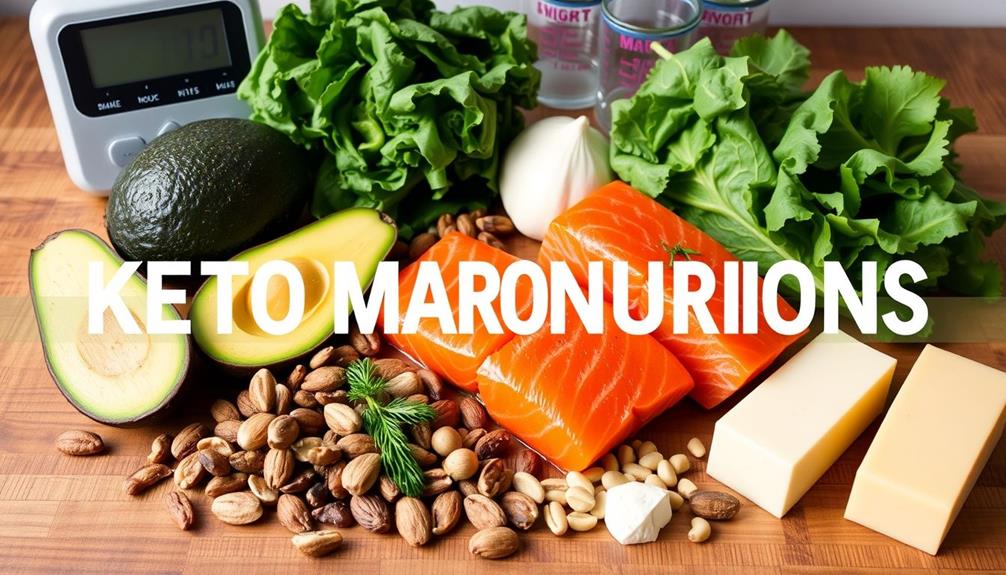
Understanding macronutrient ratios is essential for successfully following the keto diet.
You'll want to aim for 70-75% fats, 20-25% proteins, and 5-10% carbohydrates. By accurately tracking these ratios, you help your body enter and maintain ketosis, which boosts energy levels, promotes weight loss, and curbs hunger.
Sticking to these ratios also helps prevent insulin resistance and other metabolic issues, so it's wise to consult a healthcare professional for personalized advice.
Keep in mind that adjusting your ratios might be necessary based on your individual health needs. Tailoring your macronutrient intake can enhance your weight loss journey and overall well-being, ensuring you get the most out of your keto experience.
Different Types of Keto Diets
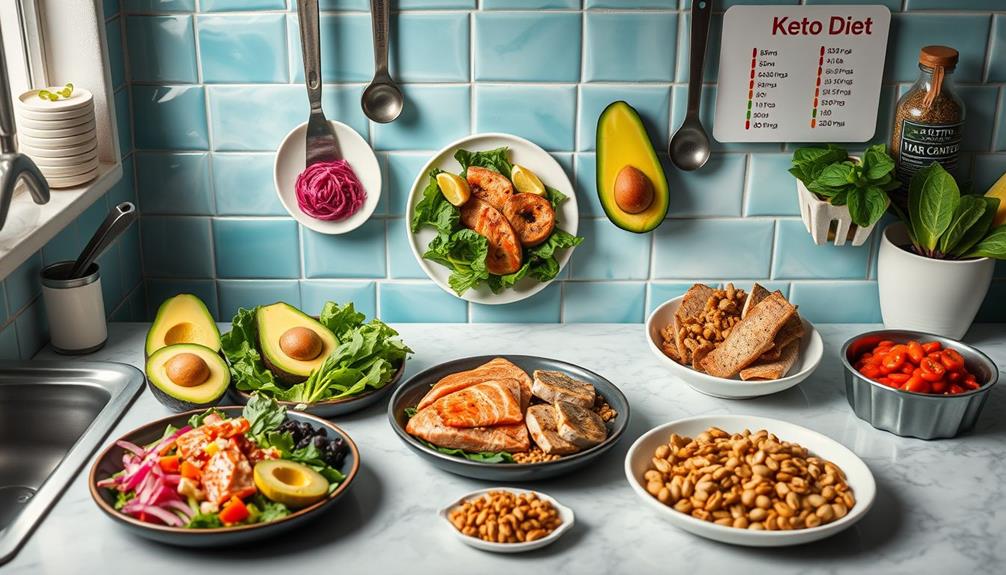
When exploring the different types of keto diets, you'll find that each variation caters to specific goals and lifestyles. Here's a quick overview:
| Type of Keto | Macronutrient Ratio | Best For |
|---|---|---|
| Standard Keto | 70-75% fats, 20-25% proteins, 5-10% carbs | General weight loss |
| High-Protein Keto | 60-65% fats, 30% proteins, 5-10% carbs | Muscle gain and resistance training |
| Cyclical Keto | 5 days keto, 2 days higher carbs | Athletes needing flexibility |
| Targeted Keto | 20-30g carbs pre-workout | High-intensity exercise |
Choosing the right type helps you achieve your goals while enjoying a sustainable lifestyle. Make sure to take into account your needs and preferences when selecting a keto diet.
Effective Tracking Methods
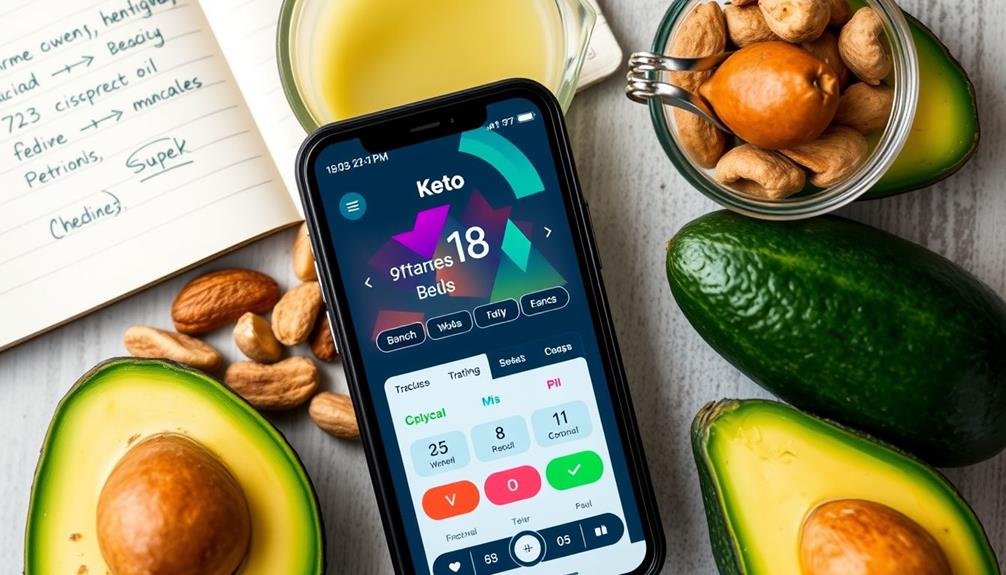
To successfully navigate the keto diet, you need effective tracking methods that keep your macronutrient intake in check.
Start by determining your daily calorie goals, ensuring you allocate around 70-75% to fats, 20-25% to proteins, and 5-10% to carbohydrates.
Use tools and apps like MyFitnessPal or Carb Manager to simplify your tracking process. These apps allow you to log foods, calculate macros, and even scan barcodes, making it easier to stay on track.
Avoid common pitfalls like mismeasuring portions and neglecting protein intake. Investing in a kitchen scale and consistently logging your meals will enhance your accountability.
Benefits of Proper Ratios
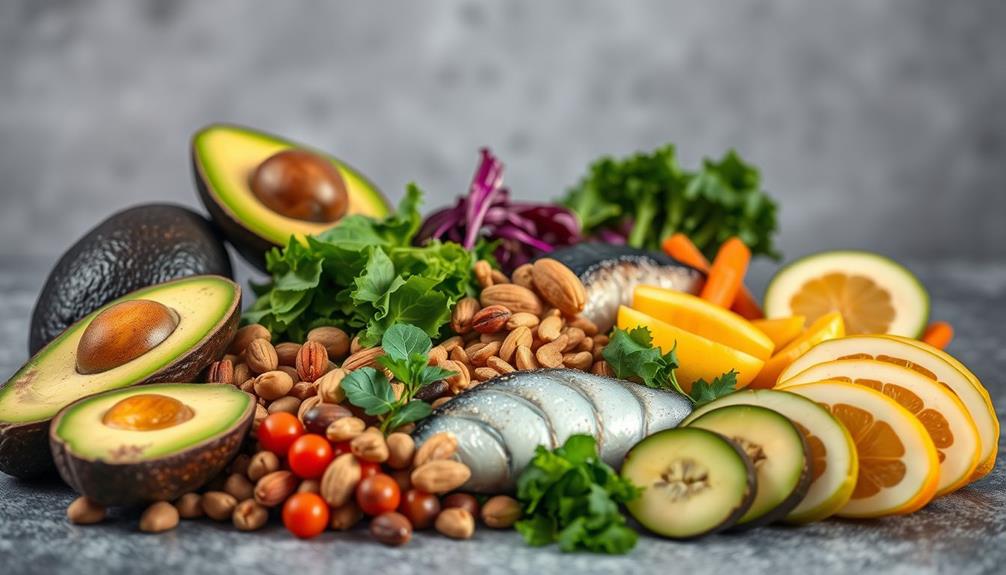
Achieving the right macronutrient ratios on a keto diet can considerably enhance your overall health and well-being. By maintaining a balance of 70-75% fats, 20-25% proteins, and 5-10% carbohydrates, you'll effectively enter and sustain ketosis.
This metabolic state boosts energy levels, promotes weight loss, and keeps hunger at bay. You'll also notice improved mental clarity and better regulation of appetite.
Proper ratios can help manage chronic conditions, preventing insulin resistance and metabolic issues. Plus, you'll enjoy the benefits of increased satiety, making it easier to stick with your diet long-term.
Ultimately, adhering to these ratios fosters a healthier lifestyle, allowing you to feel more energized and focused throughout your day.
Potential Risks of Keto

Steering through the potential risks of the keto diet requires awareness and caution.
One common issue you might face is the "keto flu," which can bring fatigue and headaches as your body adjusts to burning fat instead of carbohydrates.
Nutritional deficiencies are also a concern, particularly with potassium and magnesium, due to the limited food choices.
You may also experience digestive issues from low fiber intake, leading to constipation.
Additionally, there's an increased risk of kidney stones if you don't stay hydrated.
If you have pre-existing health conditions, it's essential to consult a healthcare professional to tailor your diet and monitor any side effects.
Being informed helps you navigate these risks effectively.
Nutritional Choices for Keto
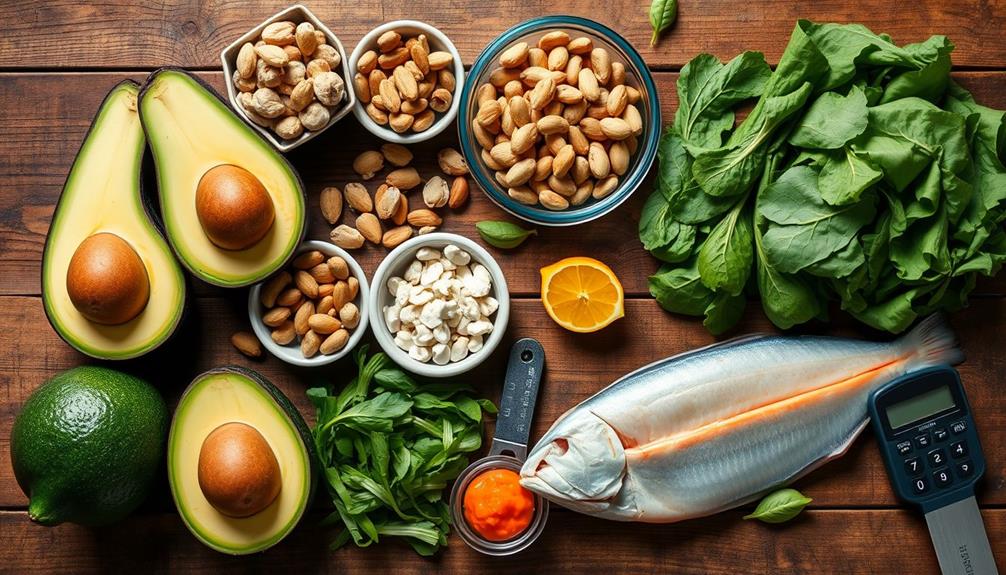
When starting on a keto diet, making smart nutritional choices is essential for success. Focus on incorporating healthy fats, low-carb vegetables, and quality protein sources into your meals. Here's a handy table to guide your food selections:
| Food Group | Keto-Friendly Options |
|---|---|
| Healthy Fats | Avocados, Olive Oil, Nuts |
| Low-Carb Veggies | Spinach, Kale, Broccoli |
| Protein Sources | Eggs, Poultry, Fish |
| Keto Desserts | Almond Flour, Stevia, Berries |
Tools for Success
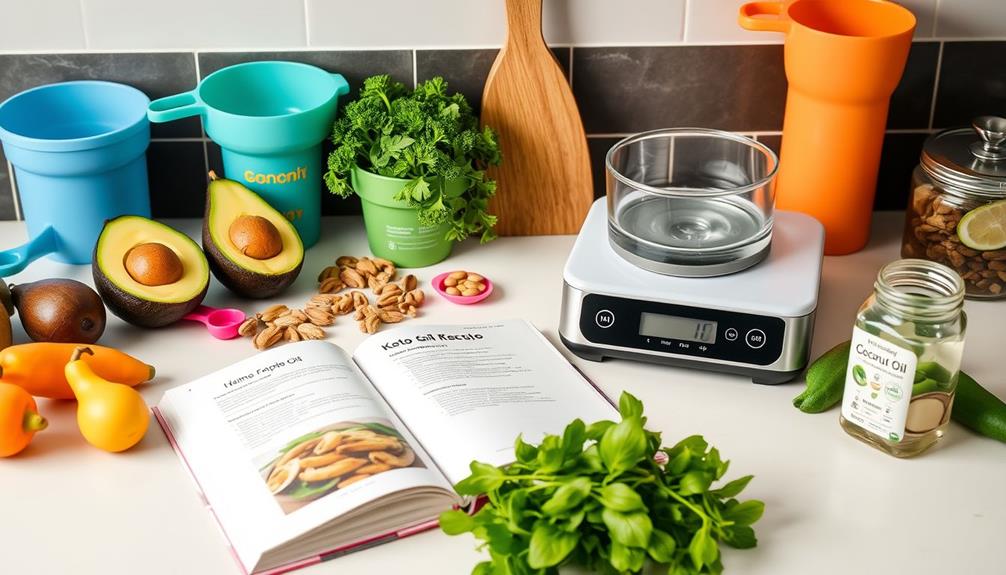
Making informed food choices is just the beginning of your keto journey. To succeed, you'll need effective tools to track your macronutrient intake.
Apps like Carb Manager, MyFitnessPal, and Cronometer simplify this process, allowing you to log meals, calculate macros, and even scan barcodes for convenience. Investing in a digital kitchen scale will help you measure food portions accurately, reducing the risk of miscalculating your calorie intake.
Additionally, keeping a food diary can enhance accountability and reveal patterns in your eating habits. Don't forget to consult a healthcare professional for personalized guidance, ensuring your diet meets your unique health needs.
With the right tools, you can confidently navigate your keto path and achieve your goals.
Frequently Asked Questions
Can I Customize My Macronutrient Ratios Based on Personal Goals?
Yes, you can customize your macronutrient ratios based on your personal goals. Adjusting ratios according to your needs helps optimize weight loss, energy levels, and overall health. Always consider consulting a healthcare professional for guidance.
How Can I Handle Cravings While on a Keto Diet?
To handle cravings on a keto diet, focus on high-fat snacks like nuts or cheese, stay hydrated, and keep busy. You can also plan meals ahead to prevent impulsive eating and maintain your goals.
What Are Some Common Keto-Friendly Snacks?
When hunger strikes, reach for keto-friendly snacks like cheese cubes or almond butter instead of chips. These satisfying options keep you in ketosis while curbing cravings, making your low-carb lifestyle easier and more enjoyable.
Is It Safe to Stay on Keto Long-Term?
Staying on keto long-term can be safe for many, but you should monitor your health closely. Consulting a healthcare professional helps guarantee you maintain nutritional balance and manage any potential side effects effectively.
How Does Alcohol Consumption Affect My Keto Ratios?
Did you know that 30% of people on keto report increased cravings for carbs when drinking alcohol? Alcohol can disrupt your keto ratios, leading to higher carb intake and potentially affecting your ketosis goals. Stay mindful!
Conclusion
Mastering macronutrient ratios is key to thriving on the ketogenic diet. Did you know that studies show up to 70% of people on a well-structured keto plan experience significant weight loss within the first month? By focusing on the right balance of fats, proteins, and carbs, you'll not only boost your energy levels but also curb those pesky cravings. So, embrace the journey, track your intake, and enjoy the delicious foods that come with a healthy keto lifestyle! In addition to macronutrient ratios, it’s also important to ensure you’re getting essential vitamins and minerals on a ketogenic diet. Green leafy vegetables, nuts, and seeds are great sources of micronutrients that can help support overall health and wellbeing. By focusing on a well-rounded approach to your keto diet, you can optimize your nutrition and feel your best. So, don’t forget to incorporate a variety of nutrient-dense foods to support your body’s needs.
